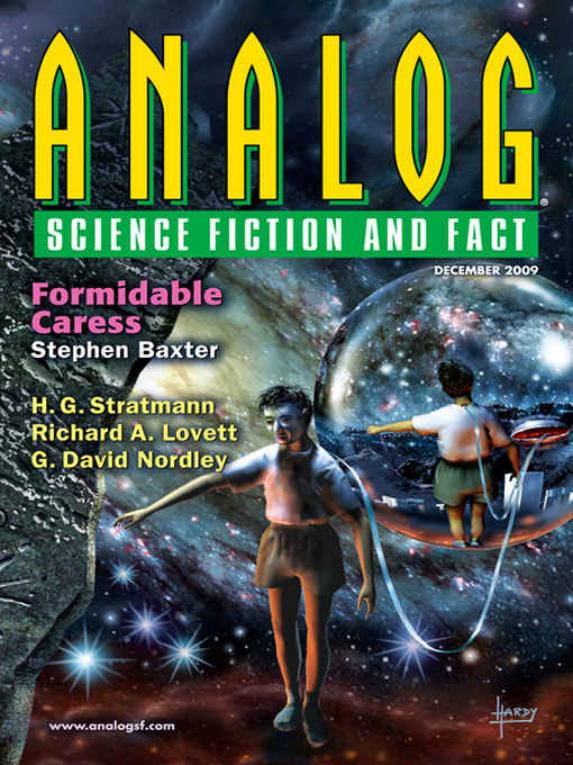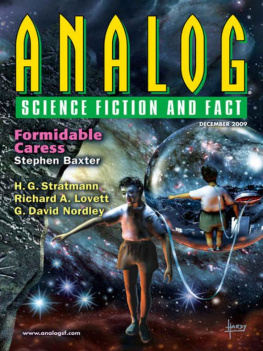Dell Magazine Authors - Analog SFF, December 2009
Here you can read online Dell Magazine Authors - Analog SFF, December 2009 full text of the book (entire story) in english for free. Download pdf and epub, get meaning, cover and reviews about this ebook. year: 2010;2006, publisher: Dell Magazines, genre: Art. Description of the work, (preface) as well as reviews are available. Best literature library LitArk.com created for fans of good reading and offers a wide selection of genres:
Romance novel
Science fiction
Adventure
Detective
Science
History
Home and family
Prose
Art
Politics
Computer
Non-fiction
Religion
Business
Children
Humor
Choose a favorite category and find really read worthwhile books. Enjoy immersion in the world of imagination, feel the emotions of the characters or learn something new for yourself, make an fascinating discovery.
- Book:Analog SFF, December 2009
- Author:
- Publisher:Dell Magazines
- Genre:
- Year:2010;2006
- Rating:4 / 5
- Favourites:Add to favourites
- Your mark:
- 80
- 1
- 2
- 3
- 4
- 5
Analog SFF, December 2009: summary, description and annotation
We offer to read an annotation, description, summary or preface (depends on what the author of the book "Analog SFF, December 2009" wrote himself). If you haven't found the necessary information about the book — write in the comments, we will try to find it.
Analog SFF, December 2009 — read online for free the complete book (whole text) full work
Below is the text of the book, divided by pages. System saving the place of the last page read, allows you to conveniently read the book "Analog SFF, December 2009" online for free, without having to search again every time where you left off. Put a bookmark, and you can go to the page where you finished reading at any time.
Font size:
Interval:
Bookmark:

Dell Magazines
www.analogsf.com
Copyright 2009 Dell Magazines
NOTICE: This work is copyrighted. It is licensed only for use by the original purchaser. Making copies of this work or distributing it to any unauthorized person by any means, including without limit email, floppy disk, file transfer, paper print out, or any other method constitutes a violation of International copyright law and subjects the violator to severe fines or imprisonment.

Peter Kanter: Publisher
Christine Begley: Vice President for Editorial and Product Development
Susan Mangan: Vice President for Design and Production
Stanley Schmidt: Editor
Trevor Quachri: Managing Editor
Mary Grant: Editorial Assistant
Victoria Green: Senior Art Director
Irene Lee: Production Artist/Graphic Designer
Carole Dixon: Senior Production Manager
Evira Matos: Production Associate
Abigail Browning: Manager, Subsidiary Rights and Marketing
Julia McEvoy: Manager, Advertising Sales
Bruce W. Sherbow: VP, Sales, Marketing, and IT
Sandy Marlowe: Circulation Services
Advertising Representative: Connie Goon, Advertising Sales Coordinator, Tel: (212) 686-7188 Fax:(212) 686-7414 (Display and Classified Advertising)
Editorial Correspondence Only: analog@dellmagazines.com
Published since 1930
First issue of Astounding January 1930 (c)
One of John W. Campbell's most famous editorials in Astounding looked at what was once a popular basis for science-fictional plotsand why it probably wouldn't work in reality. He was right, but I don't think he went far enough.
The idea was that human scientists or engineers would get their hands on a technological artifact from their own future, or from an alien civilization, and figure out how it worked and how to duplicate or even improve on it. In No Copying Allowed (November 1948), John demonstrated the improbability of this premise with a simple hypothetical example.
Suppose, he suggested, that a late 1940s guided missile screamed across a 1920 sky and into the hands of a team of U.S. Army Signal Corps engineers. It represents a technology less than thirty years beyond their own, but it's full of things they can't understand. It flies much faster than anything they've seen, yet doesn't seem to have an enginejust a simple pipe, open at both ends. We'd recognize it as a ramjet, but they don't yet have that ideanot surprising, since a ramjet won't even work unless it's already moving faster than anything that could be built in 1920. It's made of alloys of unfamiliar composition and structure, and contains electronic components that they can recognize, in a general way, but not reproduce, such as printed circuits and tiny vacuum tubes, resistors, and capacitors. There are also mysterious little objects made of solid germanium and functioning as amplifiers, but exact copies made with the purest available germanium do nothing (because, we would say, they lack the necessary doping with tiny amounts of just the right impurities).
And so on.
Looking back at John's scenario from sixty years after he wrote his editorial, we have a different perspective in at least two major ways. First, wildly advanced and incomprehensible as his 1948 missile would have seemed to engineers of less than thirty years earlier, it now looks pretty quaint to us. It used vacuum tubes, for one thinga technology now so widely forgotten that many young scientists and engineers have never seen one. (Several years ago, a young physicist at Bell Labs told me he'd always regarded vacuum tubes as rather mysterious substitutes for transistors; which, in reverse, is pretty much how I felt about transistors after having learned vacuum tubes first.) Those mysterious germanium amplifiers in Campbell's hypothetical specimen were transistors, but they were discrete transistors, something we seldom see anymore. If the engineers who built and launched that missile in 1948 got hold of one of our missilesor even many of our toys!they would have found it full of high-level integrated circuits, each the size of one of their transistors, but incorporating millions of them (plus associated circuitry). But they would have been hard put to recognize them as such, and had no hope of building anything similar.
The second way in which John's example looks different to us is that his engineers were trying to analyze and reproduce the inner workings of the gadget that had fallen into their midst. I think they would have had trouble long before that point. Even the external controlswhat we would now call the user interfacewould have been less than intuitive. And even if those of 1948 would have been reasonably easy for a user of 1920 to figure out, the ones we use now would surely have been baffling for at least a goodly while.
Consider what controls on electronic devices typically looked like in 1920 or 1948. In 1920, most units would have a simple set of functions and a simple set of controls, each with a single function and a straightforward correlation with that function. A radio, for example, would be designed to receive a signal within a single rather narrow band of radio frequencies, demodulate it to extract the audio-frequency signal the radio wave carried, and amplify that audio signal to drive a headphone or speaker at the desired volume. The controls would be an on-off switch, a tuning dial, and a volume control. Tuning was typically done with a variable capacitor rotated by a knob directly coupled to a circular dial to indicate frequency, or driving a string to move a pointer along a linear frequency scale. Either way, there was one knob that did nothing except select frequency and one indicator that did nothing except show the frequency. If other indications were needed, such as signal strength, that was done by an analog meter, with a needle pointing to the current value of that variable on a printed scale. The on-off switch could be a toggle or slide, or a push-button, or a rotary switch that clicked off counterclockwise and on clockwise. The closest such a device was likely to get to combining functions in one control was fairly common but simple: a rotary or push-button on-off switch might be combined with the volume control in a single knob. That made straightforward sense since off can be thought of as the ultimate stage of down and on as the first step up. With that semi-exception, each control did one and only one operation, and there was no other way to do that.
Things hadn't changed all that drastically by 1948, which is probably why Campbell didn't mention the additional difficulty I'm pointing out today. But they had changed significantly. Electronic devices had become more versatile and controls had begun multitasking to accommodate that fact. A radio might now cover not just a single AM band, but several of widely different frequency ranges (broadcast and shortwave), plus another using frequency modulation (FM). It might also have an input allowing a phonograph record to be played through its audio stages. So it would need at least one selector switch, most likely a rotary switch with a knob pointing to AM, FM, SW1, SW2, SW3, or PHONO. The tuning dial would still have one pointer but several parallel scales, each labeled to correspond to one of the selector positions, so it wouldn't be too hard to figure out which of the several simultaneous indications was relevant. The volume control would still be a volume control, regardless of the selector position. There might also be a tone control, or perhaps two (treble and bass). If the radio was powered up and working, the function of each control could quickly be determined by experiment, even if the experimenter couldn't read the markings. If it was not powered, there'd be more guesswork involved.
Font size:
Interval:
Bookmark:
Similar books «Analog SFF, December 2009»
Look at similar books to Analog SFF, December 2009. We have selected literature similar in name and meaning in the hope of providing readers with more options to find new, interesting, not yet read works.
Discussion, reviews of the book Analog SFF, December 2009 and just readers' own opinions. Leave your comments, write what you think about the work, its meaning or the main characters. Specify what exactly you liked and what you didn't like, and why you think so.









